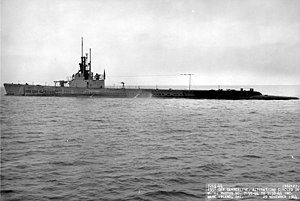Gato class submarine

USS Gato off Mare Island Navy Yard on 29 November 1944
|
|
| Class overview | |
|---|---|
| Name: | Gato class |
| Builders: | Electric Boat Company, Portsmouth Naval Shipyard, Mare Island Naval Shipyard, Manitowoc Shipbuilding Company |
| Operators: | |
| Preceded by: | Tambor class |
| Succeeded by: | Balao class |
| Cost: | $2.85 million (1940) |
| Built: | 1940–1944 |
| In commission: | 1943–1969 |
| Completed: | 77 |
| Lost: | 20 |
| Retired: | 57 |
| Preserved: | 6 |
| General characteristics | |
| Type: | Diesel-electric submarine |
| Displacement: | |
| Length: | 311 ft 8 in (95.00 m) – 311 ft 10 in (95.05 m) |
| Beam: | 27 ft 3 in (8.31 m) |
| Draft: | 17 ft (5.2 m) maximum |
| Propulsion: |
|
| Speed: |
|
| Range: | 11,000 nautical miles (20,000 km) surfaced at 10 knots (19 km/h) |
| Endurance: |
|
| Test depth: | 300 ft (90 m) |
| Complement: | 6 officers, 54 enlisted men |
| Armament: |
|
The Gato-class were a class of submarines built for the United States Navy and launched in 1941–1943; they were the first mass-production US submarine class of World War II. Together with their near-sisters the Balao and Tench classes, their design formed the majority of the United States Navy's World War II submarine fleet. Named after the first vessel of the class, USS Gato, the Gato class and its successors formed the core of the submarine service that was largely responsible for the destruction of the Japanese merchant marine and a large portion of the Imperial Japanese Navy in World War II. Gato's name comes from a species of small catshark. Like most other U.S. Navy submarines of the period, boats of the Gato class were given the names of marine creatures. In some references, the Gatos are combined with their successors, especially the Balao class.
The Gato-class boats were considered to be "Fleet Submarines". The original rationale behind their design was that they were intended to operate as adjuncts to the main battle fleet, based on Standard-type battleships since World War I. They were to scout out ahead of the fleet and report on the enemy fleet's composition, speed, and course, then they were to attack and whittle down the enemy in preparation for the main fleet action, a titanic gun battle between battleships and cruisers. This was an operational concept born from experience in World War I. In order to operate effectively in this role, a submarine had to have high surface speed, long range and endurance, and a heavy armament. Limitations in submarine design and construction in the 1920s and 1930s made this combination of qualities very difficult to achieve. The USN experimented constantly with this concept in the post-World War I years, producing a series of submarines with less than stellar qualities and reliability, the AA-1 class (also known as the T class) and the V-boats, of which V-1 through V-3 were an unsuccessful attempt to produce a fleet submarine.
...
Wikipedia
